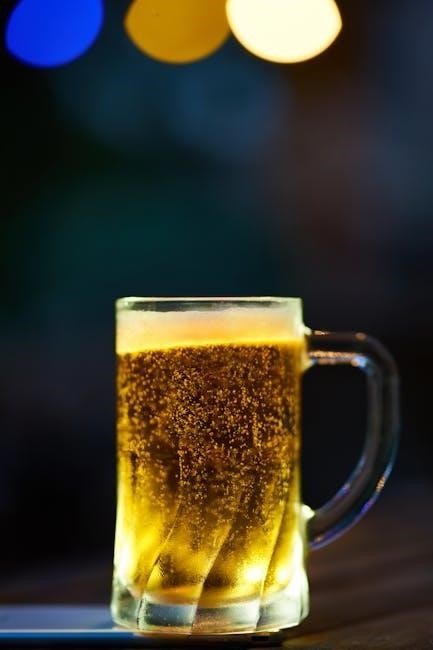Beer pong rules provide an essential guide for players, ensuring fair and fun gameplay․ Download the official Beer Pong Rules PDF for a comprehensive overview and proper regulations․
Overview of Beer Pong
Beer pong is a popular drinking game played on a long table with two teams․ Each end features 10 cups arranged in a triangle, filled with beer․ Players take turns shooting ping pong balls into opponents’ cups․ The goal is to land balls in the opposing team’s cups, which they must drink․ Variations exist, but the core objective remains the same․ Official rules and guides, like the Beer Pong Rules PDF, provide clarity for both casual and competitive play, ensuring a fun and fair experience for everyone involved․
Importance of Knowing the Rules
Understanding the rules of beer pong is crucial for ensuring fair play and maximizing fun․ Official guidelines, such as those in the Beer Pong Rules PDF, provide clarity on gameplay, scoring, and penalties․ Knowing the rules helps avoid disputes and ensures everyone plays by the same standards․ Whether hosting a casual game or competing in tournaments like the World Series of Beer Pong, having a clear understanding of the rules enhances the experience․ Downloadable resources, such as printable rule sheets, make it easy to share and follow the official regulations, fostering a more enjoyable and organized game for all participants․

Basic Rules of Beer Pong
Beer pong involves throwing a ping pong ball into opponents’ cups on a long table․ Teams alternate turns, aiming to hit cups filled with beer, following specific rules for scoring, penalties, and gameplay fairness, as outlined in the Beer Pong Rules PDF․
Number of Players and Teams
Beer pong is typically played with two players or two teams of two, though variations allow for one-on-one or larger groups․ Each team stands at opposite ends of the table, taking turns to shoot․ The official Beer Pong Rules PDF specifies that teams must alternate throws, with one player from each team shooting in sequence․ This setup ensures fair gameplay and maintains the competitive spirit․ The rules also accommodate different group sizes, making the game adaptable for various social settings․ Proper team configuration is essential for a balanced and enjoyable game, as outlined in the official guide․
Setup and Equipment
Beer pong requires a flat, smooth table, typically 8 feet long, and two sets of six cups arranged in a triangular formation at each end․ The cups are usually filled with beer, and a ping pong ball is used for shooting․ The official Beer Pong Rules PDF specifies that cups must be identical, with a standard size and arrangement․ A rinse cup for cleaning the ball is also essential․ Proper setup ensures fairness and consistency, making it a critical part of the game․ Adhering to these equipment guidelines guarantees an authentic and enjoyable experience for all players․
Objective of the Game
The primary goal in beer pong is for teams to throw a ping pong ball into their opponents’ cups․ Each team aims to eliminate all of the opposing team’s cups first․ Players take turns shooting, and the team with the last remaining cup often faces a final showdown․ The Beer Pong Rules PDF outlines that the objective is to strategize and skillfully land the ball in the cups to outperform the opposing team․ This competitive yet fun dynamic makes beer pong a popular social and party game, focusing on accuracy and teamwork to achieve victory․

Game Setup and Preparation
Setting up beer pong involves arranging cups in a triangular formation on both ends of a table․ The Beer Pong Rules PDF specifies the standard layout, ensuring equal cup distribution and proper spacing between teams for fair play․
Arranging the Cups
In beer pong, cups are arranged in a triangular formation on each side of the table․ The Beer Pong Rules PDF specifies that each team starts with 10 cups, positioned in 4 rows (4-3-2-1)․ Cups must be uniform in size and evenly spaced, with the front cup aligned to the edge of the table․ The formation ensures fair gameplay and symmetry between opponents․ Proper alignment is crucial, as misarranged cups can lead to disputes․ The official rules outline precise measurements for cup placement to maintain consistency across all games․
Filling the Cups
In beer pong, cups are typically filled with beer, though water or other liquids can be used․ The Beer Pong Rules PDF states that cups should contain enough liquid to cover the bottom, usually about 1-2 inches․ The amount can vary based on the game’s intensity, but consistency across all cups is key․ In casual games, players often fill cups partially, while tournaments may enforce uniform levels․ The liquid type isn’t specified, allowing flexibility, but beer remains traditional․ Proper filling ensures fair play and balanced gameplay for all participants․
Positioning the Players
Proper positioning is crucial in beer pong․ Players typically stand 6-8 feet apart, facing the table․ Teams line up behind their respective cup formations, ensuring they have clear access to their cups․ Each player should maintain a balanced stance, with feet shoulder-width apart, to enhance stability and throwing accuracy․ The throwing arm should be positioned comfortably, allowing for a smooth motion․ Players must stay behind the table line to avoid fouls․ Proper alignment ensures fair play and prevents disputes, as outlined in the Beer Pong Rules PDF․ Consistent positioning is key to maintaining a competitive yet enjoyable game environment․
Gameplay Rules
Players alternate shooting at opposing cups․ Hits score points; misses allow redemption․ Fouls result in penalties, ensuring fair play․
Turn Order and Shooting
Teams take turns shooting, typically determined by mutual agreement or a preliminary round like rock-paper-scissors․ Each player has 10 seconds to shoot․ If a shot is missed, the turn passes to the opposing team․ If made, the cup is removed, and the opposing team must drink immediately․ Players must shoot with both hands behind the shooting line․ Interference with the ball in mid-air results in a re-shot․ Unsportsmanlike conduct, such as distracting shooters, may incur penalties․ Proper shooting etiquette ensures fair play and maintains game flow․
Scoring and Hitting Cups
Scoring in Beer Pong is based on hitting cups․ Each cup hit earns a point, and the goal is to eliminate all opposing cups first․ When a ball lands in a cup, it is removed, and the opposing team drinks its contents․ If both players hit cups in a turn, they continue shooting․ The game ends when one team has no cups left, declaring them the winner․ Cups are typically lined up symmetrically, and hitting them strategically weakens the opponent’s setup․ Proper tracking of hits ensures accurate scoring and fair gameplay progression․
Redemption Rules
Redemption rules offer a last-chance opportunity for the losing team to tie or continue the game․ If a team has only one cup remaining and loses the turn, they can attempt redemption by making all remaining shots․ If successful, the game continues; if they miss, the opposing team wins․ Redemption adds excitement and ensures no team is defeated without a final chance to recover․ Proper execution of redemption rules maintains fairness and climax in the game’s conclusion, making it a critical aspect of Beer Pong strategy and sportsmanship․
Fouls and Penalties
Fouls in Beer Pong are actions that violate the rules, resulting in penalties․ Common fouls include interference with the ball or cups, moving a cup to avoid a hit, or improper throwing techniques․ Penalties often grant the opposing team a retry or an automatic point․ If a foul occurs on the last cup, the opposing team may win immediately․ Understanding fouls and penalties ensures fair play and maintains the integrity of the game, making it essential to adhere to these rules for a balanced and enjoyable experience for all players․
Winning the Game
A team wins when all opposing cups are successfully hit, with the last cup determining victory․ The opposing team loses once the final cup is eliminated․
When a Team Wins
A team wins beer pong when all opposing cups are successfully hit and emptied․ The last cup hit determines the victory, and the opposing team loses immediately․ The winning team celebrates, while the losing team must drink any remaining beer from their cups․ The game concludes with a clear winner, and no further shots are taken after the final cup is hit․ This rule ensures a decisive outcome, maintaining the game’s competitive nature and sportsmanship․
Final Showdown and Redemption
The final showdown occurs when both teams have one cup remaining․ Players from each team take turns shooting until one team hits their last cup, securing victory․ If a player misses, the opposing team gets a chance to redeem themselves․ Redemption allows a team to tie the game if they hit their last cup after the opposing team has already hit theirs․ This thrilling conclusion ensures that the game remains unpredictable and exciting, giving underdogs a chance to rally and extend the competition․

Common Variations of Beer Pong
Beer pong variations include regional rules, different cup arrangements, and creative twists, allowing players to customize gameplay while maintaining core objectives and competitive fun․
Double Cherry and Other Regional Variations
Double Cherry is a variation where both players on a team make their shots, earning an extra turn․ Regional variations include differing cup arrangements and rules, such as “no blowbacks” or “re-racks,” which vary by location․ Some areas allow for “house rules,” enabling customization․ These variations keep the game dynamic and adaptable, ensuring no two games are identical․ Players must familiarize themselves with local rules to avoid penalties and maintain fair play․
House Rules and Customizations
House rules allow players to tailor Beer Pong to their preferences, creating a unique experience․ Common customizations include adjusting the number of cups, changing shot distances, or modifying redemption rules․ Some groups introduce “power cups” or “wild cards” for added excitement․ Others enforce penalties like extra drinking for missed shots․ These personalized tweaks make the game more engaging and reflective of the players’ style․ House rules ensure that no two games are ever the same, keeping the tradition fresh and adaptable to any setting or group․
Strategies for Success
Mastering accuracy, consistency, and psychological tactics enhances gameplay․ Practice throwing techniques, study opponents’ weaknesses, and maintain focus under pressure to gain a competitive edge․
Mastering Your Throw
Consistency and accuracy are key to excelling in beer pong․ Practice various throwing styles, such as the arc shot or straight shot, to find what works best for you․ Focus on your grip, stance, and elbow alignment to maintain control․ Aim for the center of the cup to minimize deflection․ Develop a pre-shot routine to stay focused and calm under pressure․ Regular practice helps build muscle memory, ensuring reliable performance during games․ Mastering your throw boosts confidence and enhances your team’s chances of winning․

Psychological Tactics
Psychological tactics play a crucial role in beer pong, often separating good players from great ones․ Players can gain an edge by employing mental strategies to distract or intimidate opponents․ Trash talk, intimidating stares, and exaggerated celebrations can disrupt opponents’ focus․ Maintaining a calm and confident demeanor under pressure can also unsettle rivals․ Additionally, using positive reinforcement with teammates and negative commentary toward opponents can shift the game’s momentum․ Mastering these psychological tactics can reduce opponents’ confidence and enhance your team’s performance, making them a powerful complement to physical skill․

Official Beer Pong Rules PDF
The official beer pong rules PDF outlines standardized guidelines for gameplay, ensuring consistency in tournaments and casual games․ Download it from reputable sources for comprehensive rules․
Downloading the Official Rule Book
To access the official beer pong rules, visit the World Series of Beer Pong (WSOBP) website or other reputable sources․ The PDF guide details game setup, rules, and penalties․ It covers equipment standards, cup arrangements, and shooting procedures․ The document also outlines redemption rules and fouls․ Ensure to download from verified sources to avoid inaccuracies․ Once downloaded, the rule book serves as a comprehensive reference for both casual and competitive play, ensuring fair and organized games․ This resource is essential for understanding the game’s official guidelines․

Tournaments and Competitive Play
Beer pong tournaments, like the World Series of Beer Pong, offer competitive play with structured rules and prizes, attracting skilled players worldwide․
World Series of Beer Pong
The World Series of Beer Pong (WSOBP) is the premier international beer pong tournament, held annually in Las Vegas․ It attracts top players from around the globe, competing for cash prizes and the coveted title․ Teams face off in a double-elimination bracket, adhering to strict official rules․ The event fosters a competitive yet friendly atmosphere, with players showcasing their skills and sportsmanship․ Participation requires registration, and winners are celebrated within the beer pong community․ The WSOBP has become a cornerstone of competitive beer pong culture․
Etiquette and Sportsmanship
Respect opponents, keep the area clean, and avoid mocking․ Congratulate winners and accept losses gracefully․ Maintain a positive atmosphere and encourage good sportsmanship throughout the game․
Respecting Opponents
Respecting opponents is crucial in beer pong․ Avoid mocking or belittling others during the game․ Maintain a positive attitude, whether winning or losing․ Congratulate opponents on their successes and accept losses gracefully․ Keep the playing area clean and avoid intentional distractions․ Healthy competition is encouraged, but personal attacks or disrespectful behavior are not tolerated․ Remember, the goal is to enjoy the game together․ Respecting opponents ensures a fun and fair experience for everyone involved․ Clean up after the game and leave the space as you found it․

Safety Tips

Ensure all players are of legal drinking age․ Clean cups thoroughly before use․ Avoid excessive alcohol consumption․ Provide water to stay hydrated․ Never force drinks on others․ Maintain a safe playing environment to prevent accidents․ Designate a sober person to monitor the game․ Encourage responsible drinking and respect personal limits․ Safety should always be prioritized over gameplay;
Drinking Responsibly
Drinking responsibly is crucial in beer pong to ensure a safe and enjoyable experience for all players․ Always know your limit and pace yourself during the game․ Encourage players to drink water between turns to stay hydrated․ Never pressure others to drink more than they are comfortable with․ Designate a sober person to oversee the game and ensure safety․ If someone appears intoxicated, stop the game and offer alternative activities․ Remember, the goal is fun, not excessive drinking․ Always prioritize health and well-being over winning or continuing play․
Mastering beer pong rules enhances gameplay and ensures fun for everyone․ Always play responsibly, respect opponents, and enjoy the game with friends and competitors alike․
Final Thoughts on Beer Pong Rules

Mastering the rules of beer pong ensures a fun and fair game for everyone involved․ Whether playing casually or competitively, understanding the guidelines promotes sportsmanship and safety․ Always refer to the official beer pong rules PDF for clarity and consistency․ Remember to drink responsibly, respect your opponents, and enjoy the game․ With practice and strategy, you can become a skilled player, making every match memorable and enjoyable for all participants․ Happy ponging!

